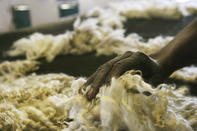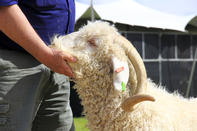Angora goats can be shorn every six months. Fleece weight varies with age - from 500g from kids to about 2 kg of fleece from adult goats. The fleece is called mohair, not angora.

Angora comes from Angora rabbits. General shearing tips: A clean goat is easier to shear than a dirty one. The goat must be dry. Clipping is easier than shearing, especially for a beginner.
Do not cut the same area twice, as long fibre lengths gives higher quality yarn. If not shorn regularly, Angora goats are susceptible to parasites and illnesses. Long hair may also limit sight and movement, which could prevent the goat from eating and drinking. It may also interfere with baby goats from suckling.
Handling of Angora Goats

When shearing Angora goats, they must be handled with patience and to allow for their natural behaviour - curious and clever. Shearing is stressful for goats and rough handling of goats must be avoided.
Goats may be caught above the heel or by the horn, depending on their ages but should never be dragged by their legs. Do not use electric prodders on goats. Goats should be put in a support or support it against your legs. Shearing should begin at the back-end and work forwards. Go slow and shear close to the goat’s body.
Hygiene During Shearing
Prevention of disease transmission is very important during shearing. Shearing equipment and shearers (hand or machine shearers) can spread infectious diseases within a flock or between flocks, so the correct disinfection procedures must be followed. Start shearing young goats first to prevent disease transmission from older animals.
Before shearing commences the entire shearing shed should be cleaned and disinfected. After the completion of shearing, all mohair should be classed, packed and removed from the shed as well as disinfecting the shearing equipment. Shearing equipment should be disinfected at regular intervals during shearing to stop the spread of disease.
If a shearer has cut an abscess on a goat, the shearer should change into a clean pair of trousers. The shearing area must also be disinfected. Dead animals should not be skinned in a shearing shed and sick animals should not be housed in a shearing shed.
Skins and pelts should not be treated, dried or stored in a shearing shed. Shearing should preferably be done by accredited shearers. Make sure shearing cuts are treated with a disinfectant and a fly repellent wound oil to prevent infection. Goats should get food and fresh water as soon as possible after shearing.
Take care not to expose shorn goats to adverse weather conditions such as cold and wet weather. Make sure they have shelter and add some high energy food to their rations.